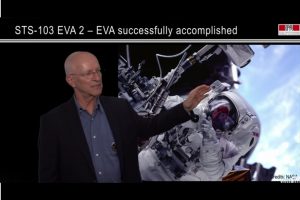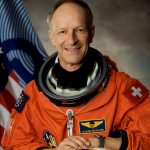CURRENT COURSE
Space Mission Design and Operations is currently in Self-paced mode.
More information and registration here.
PREVIOUS COURSE
Space Mission Design and Operations
2020

Learn the concepts used in the design of space missions, manned or unmanned, and operations, based on the professional experience of the lecturer.
Space exploration is truly fascinating. From Sputnik to the Apollo, followed by the assembly and exploitation of the International Space Station and the successful operation of the Hubble Space Telescope and other space observatories, we are uncovering many mysteries of our universe. We also made huge progress learning how to work and be productive in outer space!
This course builds on university level physics and mechanics to introduce and illustrate orbital dynamics as is applied in the design of space missions. Simple tools will be provided to allow planning of missions on orbit around Earth or in the Solar System. You will learn from the experience of Claude Nicollier, one of the first ESA astronauts, specifically through his involvement in the Shuttle project and his role in the maintenance of the Hubble Space Telescope on two occasions.
This course builds on university level physics and mechanics to introduce and illustrate orbital dynamics as they are applied in the design of space missions. You will learn from the experiences of Claude Nicollier, one of the first ESA astronauts, specifically through his role in the maintenance of the Hubble Space Telescope on two occasions. The course focuses on conceptual understanding of space mechanics, maneuvers, propulsion and control systems used in all spacecraft. You will gain knowledge of the challenges related to the use of the space environment as a scientific and utilitarian platform.
What you’ll learn
- Fundamental laws of mechanics and orbital mechanics
- Orbital maneuvers
- Types of space missions and their objectives
- Space environment
- General concepts of space vehicle architecture
- Propulsion
- Attitude determination and control
- Onboard systems
- Risk management and reliability
- Key design elements for successful missions, in particular related to human spaceflight
Unit 0 – Introduction to the Course
• Course objectives
• Motivation behind space exploration and utilization
• The space pioneers, and brief history of human space exploration
• The main space agencies in the world
• Space utilization and exploration
Unit 1 – Introduction to Space Environment
• Review of laws of mechanics
• Introduction to the space environment including the transition from the atmosphere to space, microgravity, the electrical and thermal environments, orbital lifetime, space debris and asteroids/comets collision threats
Unit 2 – Introduction to Orbital Mechanics (I and II)
• Orbital Mechanics I – dynamics of spaceflight; concept of gravitational well; orbital motion; Kepler’s Laws; the case of circular orbits
• Orbital Mechanics II – elliptical orbits; reference frames; orbital maneuvers; perturbations of orbital motion; peculiar orbits
Unit 3 – Orbital Mechanics Part III
• Rendezvous in Low Earth Orbit (LEO); relative motion of the chaser vs. the target. Strategy to successfully achieve a rendezvous in LEO
Unit 4 – Orbital Mechanics Part IV
• Interplanetary trajectories; Gravity Assist or Slingshot maneuvers
• Propulsion in space – law of propulsion; concept of specific impulse; types of thrusters; electric propulsion; ascent into space, and re-entry
Unit 5 – Introduction to Space Systems and Space Tethers
• Attitude measurement and control; attitude change; electrical power generation and distribution (overview); thermal balance (overview)
• Space tethers (or cables) as an alternate method to generate electrical power on orbit; Dynamic applications of space tethers, Shuttle-based tether missions
• Reliability; systems redundancy; risk management; safety design for space systems; human rating concept
Unit 6 – The Space Shuttle and the International Space Station (ISS)
• Space Shuttle – concept; design; operations; Challenger and Columbia accidents
• ISS; Soyuz and Progress; Logistic supply to ISS with ATV, HTV, and commercial vehicles
Unit 7 – Special Subjects on Human Spaceflight, and Future of Space Exploration
• Extravehicular Activity (EVA) and space suits, space robotics
• Astronaut training , commercial space , suborbital flights
• Orion and the Space Launch System (SLS)
• Future of Space Exploration and Conclusion

Prof. Claude Nicollier

MOOC Space Mission Design and Operations 2020
Space Mission Design and Operations
2019

Space exploration is a very exciting subject. Consider the achievements of Sputnik 1, Yuri Gagarin’s first flight in space, the Apollo missions to the Moon, followed by the Shuttle program, the Hubble Space Telescope launch and maintenance on orbit, and finally the assembly and exploitation of the International Space Station. These were challenging undertakings involving space agencies and industrial teams of several nations, and private companies as well. Space telescopes are in service, and several components of the solar system have been and are still actively visited by a number of unmanned probes and robots providing us with precious knowledge about our space environment as well as the far away Universe.
This course builds on university level physics and mechanics to introduce and illustrate orbital dynamics as is applied in the design of space missions. Simple tools will be provided to allow planning of missions on orbit around Earth or in the Solar System. You will learn from the experience of Claude Nicollier, one of the first ESA astronauts, specifically through his involvement in the Shuttle project and his role in the maintenance of the Hubble Space Telescope on two occasions.
The course focuses on conceptual understanding of space mechanics, maneuvers, propulsion and control systems used in all spacecraft. You will gain knowledge of the challenges related to the use of the space environment as a platform for scientific and utilitarian purposes.
What you’ll learn
- Fundamental laws of mechanics and orbital mechanics
- Orbital maneuvers
- Types of space missions and their objectives
- Space environment
- General concepts of space vehicle architecture
- Propulsion
- Attitude determination and control
- Onboard systems
- Risk management and reliability
- Key design elements for successful missions, in particular related to human spaceflight
Unit 0 – Introduction to the Course
• Course objectives
• Motivation behind space exploration and utilization
• The space pioneers, and brief history of human space exploration
• The main space agencies in the world
• Space utilization and exploration
Unit 1 – Introduction to Space Environment
• Review of laws of mechanics
• Introduction to the space environment including the transition from the atmosphere to space, microgravity, the electrical and thermal environments, orbital lifetime, space debris and asteroids/comets collision threats
Unit 2 – Introduction to Orbital Mechanics (I and II)
• Orbital Mechanics I – dynamics of spaceflight; concept of gravitational well; orbital motion; Kepler’s Laws; the case of circular orbits
• Orbital Mechanics II – elliptical orbits; reference frames; orbital maneuvers; perturbations of orbital motion; peculiar orbits
Unit 3 – Orbital Mechanics Part III
• Rendezvous in Low Earth Orbit (LEO); relative motion of the chaser vs. the target. Strategy to successfully achieve a rendezvous in LEO
Unit 4 – Orbital Mechanics Part IV
• Interplanetary trajectories; Gravity Assist or Slingshot maneuvers
• Propulsion in space – law of propulsion; concept of specific impulse; types of thrusters; electric propulsion; ascent into space, and re-entry
Unit 5 – Introduction to Space Systems and Space Tethers
• Attitude measurement and control; attitude change; electrical power generation and distribution (overview); thermal balance (overview)
• Space tethers (or cables) as an alternate method to generate electrical power on orbit; Dynamic applications of space tethers, Shuttle-based tether missions
• Reliability; systems redundancy; risk management; safety design for space systems; human rating concept
Unit 6 – The Space Shuttle and the International Space Station (ISS)
• Space Shuttle – concept; design; operations; Challenger and Columbia accidents
• ISS; Soyuz and Progress; Logistic supply to ISS with ATV, HTV, and commercial vehicles
Unit 7 – Special Subjects on Human Spaceflight, and Future of Space Exploration
• Extravehicular Activity (EVA) and space suits, space robotics
• Astronaut training , commercial space , suborbital flights
• Orion and the Space Launch System (SLS)
• Future of Space Exploration and Conclusion

Prof. Claude Nicollier

MOOC Space Mission Design and Operations 2019
Space Mission Design and Operations
2018

Space exploration is truly fascinating. From the Sputnik mission to the assembly and exploitation of the International Space Station or the Apollo program, we are just beginning to uncover the many mysteries of our universe!
This course builds on university-level mechanics to introduce and illustrate orbital dynamics as they are applied in the design of space missions. You will learn from the experiences of Claude Nicollier, one of the first ESA astronauts, specifically, his role in the maintenance of the Hubble Space Telescope with NASA.
The course focuses on conceptual understanding of space mechanics, manoeuvers, propulsion and control systems used in all spacecraft. Learners will gain knowledge of the challenges related to the use of the space environment as a scientific and commercial platform.

Prof. Claude Nicollier
Starting 14 March 2018
Space Mission Design and Operations
2016

Space exploration is truly fascinating. From the Sputnik mission to the assembly and exploitation of the International Space Station or the Apollo program, we are just beginning to uncover the many mysteries of our universe!
This course builds on university-level mechanics to introduce and illustrate orbital dynamics as they are applied in the design of space missions. You will learn from the experiences of Claude Nicollier, one of the first ESA astronauts, specifically, his role in the maintenance of the Hubble Space Telescope with NASA.
The course focuses on conceptual understanding of space mechanics, manoeuvers, propulsion and control systems used in all spacecraft. Learners will gain knowledge of the challenges related to the use of the space environment as a scientific and commercial platform.

Prof. Claude Nicollier
– February 24, 2016: Release of the first week of the online course of Claude Nicollier on edx.org “Space Mission Deisgn and Operations”. More information and registration (mandatory to access the videos) here.
– March 2, 2016: Release of the second week of the online course of Claude Nicollier on edx.org. More information and registration (mandatory to access the videos) here. Interviews of Thomas Schildknecht and Muriel Richard-Noca about Space Debris.
– March 9, 2016: Release of the third week “Introduction to orbital mechanics” of the online course of Claude Nicollier on edx.org. More information and registration (mandatory to access the videos) here. Guest speaker: Andrea Accomazzo, ESA Rosetta flight director.
– March 16, 2016: Release of the fourth week of the online course of Claude Nicollier on edx.org. More information and registration (mandatory to access the videos) here.
– March 23, 2016: Release of the fifth week “Interplanetary trajectories and propulsion” of the online course of Claude Nicollier on edx.org. More information and registration (mandatory to access the videos) here.
– March 30, 2016: Release of the sixth week “Introduction to space systems” of the online course of Claude Nicollier on edx.org. More information and registration (mandatory to access the videos) here.
– April 6, 2016: Release of the seventh week “Past and current space missions, commercial space and satellite” of the online course of Claude Nicollier on edx.org. More information and registration (mandatory to access the videos) here.
– April 13, 2016: Release of the last week of the online course of Claude Nicollier on edx.org “Space Mission Deisgn and Operations”. More information and registration (mandatory to access the videos) here. Guest Speaker: Carol Christian, project scientist for Hubble Space Telescope.
– April 27, 2016: Final day to register and get the access to the online course of Claude Nicollier on edx.org “Space Mission Deisgn and Operations” including the videos of guest speakers. Registration here.